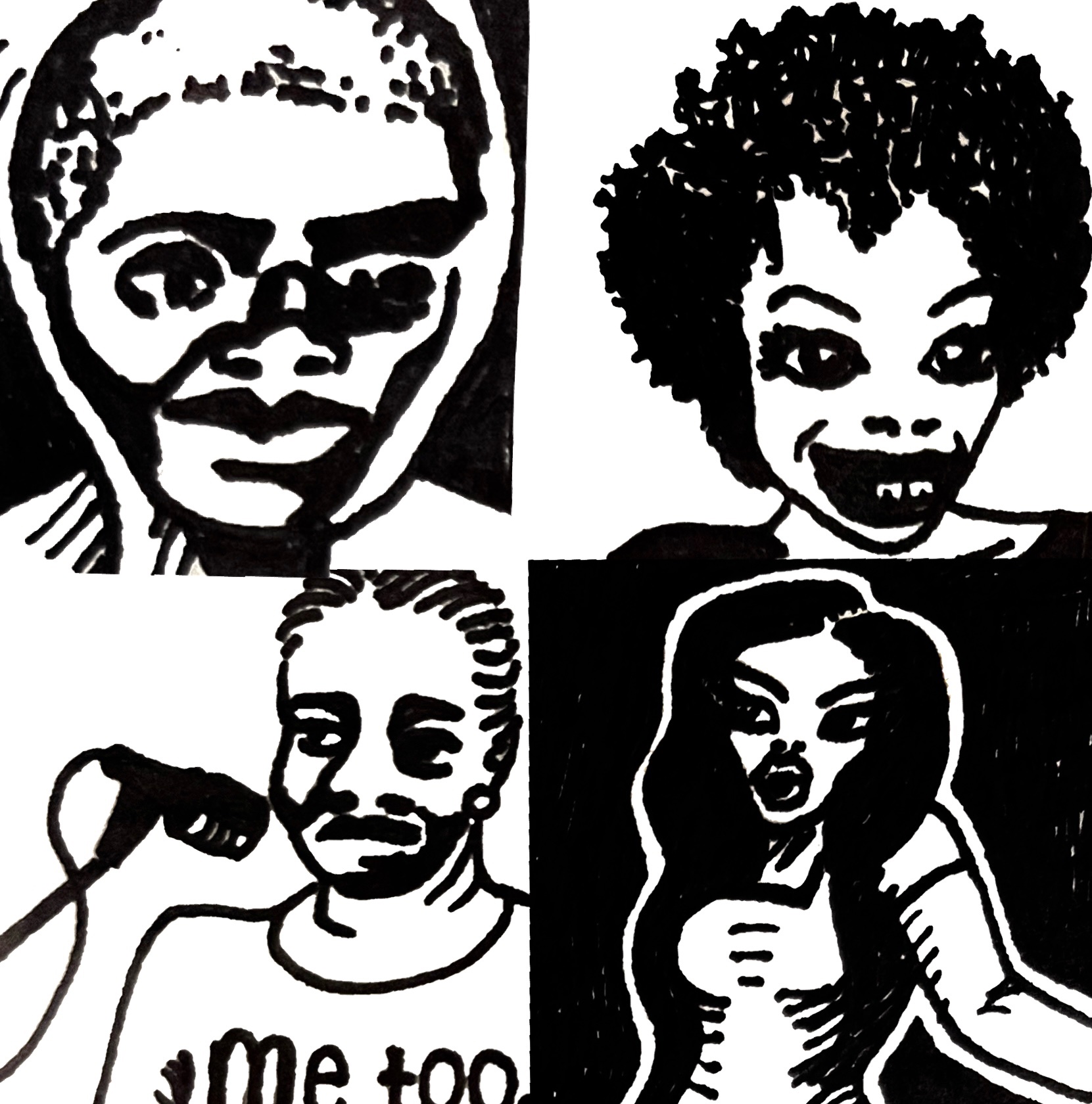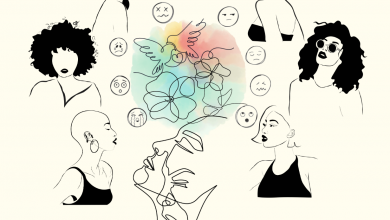Feminism 101: Misogynoir

Design by Coral Utnehmer
Image Description: Black and white drawing of four women’s heads and shoulders. One has a neutral expression and is looking to the side, one is smiling, one stands in front of a microphone with a shirt reading ‘Me Too‘ and one is posing with an arm to the side.
In 1851, Sojourner Truth asked, “Ain’t I a woman?” Ever since race was conceptualized, Black women have wondered what makes them different from other women. Why is Black womanhood discredited? Why do Black women have to look or carry themselves a certain way to be considered women?
Sojourner Truth’s speech exemplifies the idea of misogynoir. Misogynoir, a term coined by Black writer and professor Moya Bailey, refers to the special type of discrimination within misogyny that not only holds prejudice against Black women for being women but also for being Black. First conceptualized by Bailey in 2008 and became popularized in 2010, misogynoir at its core is the recognition of the intersectionality of racism, sexism, and colorism that Black women face.
Black women every day face immense scrutiny that their non-Black counterparts do not for things like speech, hair, and clothing. Black trans women are also greatly overrepresented among victims of transphobic hate crimes.
Bailey states that misogynoir in America stems from a long history of mistreatment and stereotyping of Black women starting with the hypersexualization of enslaved Black women to justify rapes, all the way to viewing Black women as the non-vulnerable and strong beyond belief to justify putting Black women in front lines of violence.
Throughout history, Black women have been given an identity that fits the current narrative that white people set out for them.
Media is one of the main leaders in influencing stereotypes about black women. Mammy, Jezebel, and Sapphire have all been popular in media like movies and television shows. Defined by the Jim Crow Museum of Racist Memorabilia, a Mammy is an “…image [that] served the political, social, and economic interests of mainstream white America. During slavery, the mammy caricature was posited as proof that Black people—in this case, Black women—were contented, even happy, as slaves. Her wide grin, hearty laugher, and loyal servitude were offered as evidence of the supposed humanity of the institution of slavery.” Like the “mammy” character in Gone With the Wind who serves as a maternal figure for the main white rich woman in the story, Mammy finds joy in serving the house she is enslaved in.
The Jim Crow Museum of Racist Memorabilia also says that the Jezebel stereotype came about when “Historically, white women, as a category, were portrayed as models of self-respect, self-control, and modesty – even sexual purity, but Black women were often portrayed as innately promiscuous, even predatory.” Jezebel characters saw a spike in representation in the media during the 1970s where Black women were overly sexualized in movies and television. Specifically in movies like Foxy Brown, while they portrayed a Black woman in an action role which is usually given to men the main character was a Black woman who is described in the movie as a “whore” with a vendetta. The Jim Crow Museum of Racist Memorabilia further defines the Sapphire as “as rude, loud, malicious, stubborn, and overbearing.” Sapphire stereotypes can be seen in media as the “angry Black woman” stereotypes which have appeared lately in reality television portrayals of Black women as aggressive and mean, usually towards white contestants. Black women as a whole are often underrepresented in media, and when they are represented, they are heavily characterized by stereotypes.
These stereotypes have detrimental consequences not only for how other people treat Black women but also for how Black women treat themselves from a very young age.
Young Black girls are held to a higher appearance standard physically, mentally, and socially. or else society. You can’t have any self-expression or you are weird or “acting white.” You can’t go out past a certain time, looking a certain way, or with certain people or you’re “being fast.” You can’t wear your natural hair or in braids like the white girls because you will be seen as “distracting” and “unkempt.” You can’t be too loud or you’re being “ratchet” and “ghetto.”
From a young age, Black women are put under immense pressure to present themselves in a higher standard than other non-Black women. It is drilled into Black girls’ brains that they have to keep their appearances up and carry themselves a particular way so that they won’t appeal to the stereotypes set on them. Black girls are told not to wear shorts too short so they won’t appeal to the Jezebel stereotype, but Black girls are still oversexualized no matter what they wear. For example, in school, Black girls are dress coded at a higher rate than any of their peers due to the adultification (when adult traits and behaviors are attributed to children) of young Black girls.
Black women are made hyper-aware of their identities and appearances from adolescence and are forced into a box where they cannot explore anything outside the box or make mistakes. Deferring from this cage of norms will lead to being ridiculed and dehumanized.
Black women face mass discrimination not only from people who don’t share their identities but also from Black men and non-Black women.
Black men participate in misogynoir not only by ragging on Black women and not protecting Black women but also by being colorist within the Black community. Most prevalent in rap and hip-hop,(even dark-skinned) Black men claim to have preferences towards lighter-skinned black women or non-Black women. This “preference” is rooted in colorism. From when A$AP Rocky said dark-skinned women do not look good in red lipstick to when Chris Brown kicked dark-skinned women out of parties, it’s blatantly obvious that colorism runs rampant among Black men in hip-hop.
Non-Black women are also repeat offenders of misogynoir. Non-Black women are known to disrespect Black women when entering interracial relationships by saying that their significant other wouldn’t want to date a Black woman and that Black women are up in arms about them dating a Black man when, in fact, most non-Black women in interracial relationships adopt Black culture and features to try to appear as Black women, or become people who “don’t see color” regarding being with a Black man.
White women are also known to leave Black women out of major movements and political endeavors. For example, there is a growing disparity between Black women’s rights fighters and white women’s rights fighters. Black women find trouble identifying themselves as feminists, as feminism has a long history of excluding Black women and perpetuating misogynoir by dismissing Black women and their concerns.
These are just some common examples of how Black women are met with racism, sexism, and colorism that is reserved especially for them. Still, misogynoir is not a concept that exists solely within everyday interactions.
Misogynoir does not hold just interpersonal consequences, but also institutional ones. Misogynoir and all its inequality can most likely be explained by the fact that Black women have the least approximation to white men, which makes them, in a socio-economic perspective, the least desirable humans. One in four Black women will be sexually abused before the age of eighteen. One in three will experience sexual assault in their lifetime. Black girls and women account for about 15% of the United States population, but make up 34% of missing persons reports in the United States. Black women are also 2.5 times more likely to be murdered by men than their white counterparts.
Harm committed towards Black women only gets progressively worse when they are trans. Within misogynoir is also transmisogynoir, a term coined by womanist writer Trudy to describe the intersectionality of anti-blackness and cissexism. Black trans women challenge the idea of traditional womanhood and are met with mass discrimination from non-black people, Black people, and others within the LGBTQIA+ community. Mass discrimination against Black trans women has devastating consequences. For example, 42% of Black trans women have been homeless at least once in their life. As of 2016, 47% of Black trans women have reported some type of violence being directed towards them, and Black trans women are 14% more likely to be attacked compared to Black trans men and Black non-binary individuals.
Misogynoir explains why little Black girls do not get found by the police as often as little white girls. Misogynoir can explain why you have heard about the mass incarceration of Black men but not the mass incarceration of Black women. Misogynoir can explain why you may be aware of police fatally shooting Black men in America but may not know that police have fatally shot 250 Black women since 2015.
As Malcolm X once said, “The most disrespected person in America is the Black woman. The most unprotected person in America is the Black woman, The most neglected person in America is the Black woman.” Unfortunately, America is not the only witness to misogynoir.
Like in the United States, Black women in Europe are often hypersexualized. In countries in Latin America, Black women are subjugated to violence and discrimination based on gender, racial, and socioeconomic discrimination.
Black women are systemically forgotten throughout the world and yet, they’re expected to carry the world on their backs. Anti-racist movements have tended to ignore the role of gender and feminist movements often center on white cisgender women. Black women and their issues are rarely put on the front stage. Black women have been silent partners in plenty of movements, like the women’s suffrage movement and the Civil Rights movement, and have always stood up for change, but when the time comes to protect and support Black women, no one is there.
Unfortunately, the mass violence and silencing of Black women can lead to internalized misogynoir. It is thrown in Black womens’ faces every day that they are not desirable or appreciated, so they internalize these myths. Black women believe they are unloveable and undateable because they have been degraded all of their lives, so they have lower dating and marriage rates compared to their non-Black counterparts. Black women start believing the stereotypes pushed on to them and behave in accordance with those stereotypes. Black women are 10 times as likely to struggle with depression, but because of unemotional and non-vulnerable stereotypes, they are some of the lowest reporters of depression.
While misogynoir seems like an end-all-be-all for Black women, there has been a major fight against the institutionalized discrimination specific to Black women. Along with other women all over the world, Black women have responded to the racism and prejudice shown by white feminism by developing their own feminist movement called “Womanism.” The rise of social media has also allowed for Black women to fight against misogynoir and be heard about their concerns and the unjust treatment they receive. In one case, Chennel “Jazzy” Rowe went viral on Twitter for reporting her white roommate, Brianna Brochu, who was poisoning her using menstrual blood, to get her school to actually respond to her claims. Since then Brochu has been charged with two misdemeanors.
Misogynoir is not the end for Black women across the globe. Living a life of stereotypes and hardship given to you based on your race and gender is not an easy life to live, but, surely, Black women are breaking away from the mold of being inexpressive and strong beyond belief to become human. Although we have a long way to go, Black women are making huge strides in rehumanizing themselves. Still, Black women are not able to do this on their own, as much as society has forced them to do so.
In order to reverse the harm that’s been done, Black women require allies. You can help by making sure you are educated on how certain events could affect Black women not only as women or Black people, but as Black women. In order to fully understand the complexities of life as a Black woman, an intersectional perspective is necessary.
You can also support Black women by being active in movements like the #MeToo movement, a social movement against sexual harassment and violence that doesn’t try to silence Black womens’ narrative, and is led by a Black woman. In addition, the #SayHerName movement seeks to raise awareness for police brutality against Black women. The person who may be harmed the most when participating in any movement is a Black woman. It is important that Black women have people who would be able to advocate for them and stand up for them when it is harmful for them to do so themselves. Black women have been fighting everyone’s battles since battles could be fought. It is time that someone helps us fight ours.
To be an ally you must be mindful of the way you speak to and about and engage with Black women. Stereotypes given to Black women are reinforced in everyday life, so it is important that you yourself are not doing or saying anything that contributes to the systematic oppression Black women have to face every day. Analyze how you view the Black women you see daily or be mindful about how the type of media you consume is portraying Black women.
Misogynoir is a systematic form of oppression that is going to take a lot of time to undo and correct, not only others’ perception of Black women, but also Black womens’ perception of themselves. But it is not impossible. Black women are the strongest people I know and have encountered, but every fight does not have to be a Black women’s fight. Black women do not have to be strong all the time. It is time for us to spread our wings and fly out of this cage that we are put in. As poet Maya Angelou put it, “for the caged bird sings of freedom.”




